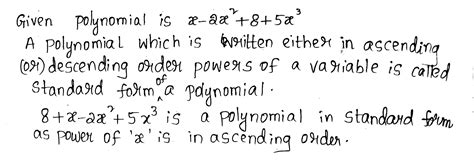Polynomials are a fundamental concept in algebra, and writing them in standard form is an essential skill for any math student. In this article, we will explore the world of polynomials and provide a step-by-step guide on how to rewrite them in standard form with ease.
Understanding Polynomials

A polynomial is an expression consisting of variables and coefficients combined using only addition, subtraction, and multiplication. The variables are typically represented by letters such as x, y, or z, while the coefficients are numerical constants. For example, 3x^2 + 2x - 4 is a polynomial.
Polynomials can have one or more terms, and each term can have a different degree. The degree of a polynomial is the highest power of the variable in any of its terms. For instance, the degree of the polynomial 3x^2 + 2x - 4 is 2, because the highest power of x is 2.
What is Standard Form?

Standard form is a way of writing polynomials in a specific order. In standard form, the terms are arranged in descending order of their degrees. This means that the term with the highest degree comes first, followed by the term with the next highest degree, and so on.
For example, the polynomial 3x^2 + 2x - 4 is already in standard form, because the term with the highest degree (3x^2) comes first. However, the polynomial 2x - 4 + 3x^2 is not in standard form, because the term with the lowest degree (2x) comes first.
Why is Standard Form Important?
Writing polynomials in standard form is important for several reasons:
- It makes it easier to compare and add polynomials.
- It allows us to identify the degree of the polynomial at a glance.
- It is essential for performing various algebraic operations, such as factoring and dividing polynomials.
Step-by-Step Guide to Rewriting Polynomials in Standard Form

Rewriting polynomials in standard form is a simple process that involves rearranging the terms in descending order of their degrees. Here's a step-by-step guide:
- Identify the terms of the polynomial.
- Determine the degree of each term.
- Arrange the terms in descending order of their degrees.
- Write the polynomial in standard form.
Let's use the polynomial 2x - 4 + 3x^2 as an example. Here's how we can rewrite it in standard form:
- Identify the terms: 2x, -4, and 3x^2.
- Determine the degree of each term: 2x has a degree of 1, -4 has a degree of 0, and 3x^2 has a degree of 2.
- Arrange the terms in descending order of their degrees: 3x^2, 2x, -4.
- Write the polynomial in standard form: 3x^2 + 2x - 4.
Tips and Tricks for Rewriting Polynomials in Standard Form
Here are some tips and tricks to help you rewrite polynomials in standard form:
- Always identify the terms and their degrees before rearranging them.
- Use a consistent method for determining the degree of each term.
- Make sure to write the polynomial in descending order of the degrees.
- Use parentheses to group terms with the same degree.
Common Mistakes to Avoid

Here are some common mistakes to avoid when rewriting polynomials in standard form:
- Forgetting to identify the terms and their degrees.
- Not arranging the terms in descending order of their degrees.
- Using the wrong method for determining the degree of each term.
- Not using parentheses to group terms with the same degree.
Practical Examples
Here are some practical examples to help you practice rewriting polynomials in standard form:
- Rewrite the polynomial 2x^2 + 3x - 4 in standard form.
- Rewrite the polynomial x^3 - 2x^2 + 3x - 1 in standard form.
- Rewrite the polynomial 3x^2 - 2x + 4x^3 in standard form.
Conclusion
Rewriting polynomials in standard form is a simple process that requires attention to detail and a basic understanding of algebra. By following the step-by-step guide and tips and tricks outlined in this article, you can master the art of rewriting polynomials in standard form. Remember to practice regularly to become proficient in this essential algebraic skill.
What is the purpose of rewriting polynomials in standard form?
+Rewriting polynomials in standard form makes it easier to compare and add polynomials, identify the degree of the polynomial, and perform various algebraic operations.
How do I determine the degree of a polynomial?
+The degree of a polynomial is the highest power of the variable in any of its terms.
Can I use parentheses to group terms with the same degree?
+Yes, using parentheses to group terms with the same degree can help clarify the polynomial and make it easier to read.
